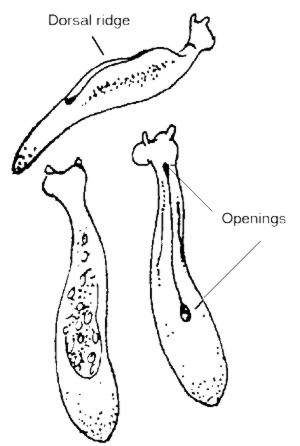Halimeda sea slug
July 25, 1999
From: Eirik Mack Eilertsen

After stirring up a large cluster of Halimeda sp. in one of my saltwater tanks, I noticed what appeared to be a piece of Halimeda stuck on the front glass. On closer inspection it turned out to be a magnificently well camouflaged nudibranch.
It measured about 1" and was completely green except for a pair of small, white antennae.
It had some sort of ridge on the dorsal side, which seemed to be made up by the nudibranch folding its skin. Notice on the figure how the hollow ridge ends in two small openings, one in each end. It moved in a caterpillar-like fashion, now and then lifting its head and about half of its body from the substratum, as if to take a good look around. I have only a few times been able to spot it when its attached to the Halimeda macro algae in my tank. The dorsal ridge gives it the same kind of flattened appearance as the individual segments of the algae, its head making up a smaller segment with the antennae looking pretty exactely like new shoots.
Can you please help me identify this beautiful slug?
Thanks in advance!
Eirik
eirike@stud.nfh.uit.no
Eilertsen, E.M., 1999 (Jul 25) Halimeda sea slug. [Message in] Sea Slug Forum. Australian Museum, Sydney. Available from http://www.seaslugforum.net/find/1114Dear Eirik,
Do you know where the Halimeda came from, or is this like your earlier find of Tritoniopsis elegans, a lucky bonus from your aquarium shop?
From your drawings and detailed description I am pretty sure I can identify your animal as Elysiella pusilla. It is not actually a nudibranch, but it is an opisthobranch sea slug belonging in the ORDER Sacoglossa. If you have a look in the Species List at the names listed under Sacoglossa you will find the diversity and variety of shape in the sacoglossans is nearly equal to the nudibranchs, even if only a few are as brightly coloured. What is more remarkable is that all the sacoglossans are herbivores feeding by sucking cell sap from algae. Elysiella pusilla, like most sacoglossans is very specialised, feeding on only one or a small group of algae, in this case in the genus Halimeda. This genus of seaweeds are unusual because they have a calcareous outer skeleton. Because this makes the plant effectively rigid, it is broken into chains of jointed segments so that it can move in the currents without breaking.
The plant grows by adding new segments at the tip of each 'branch'. These new and growing segments are softer and more lightly calcified than the older segments, and Elysiella is usually found, well-camouflaged, on these younger segments. Interestingly, most new growth in Halimeda occurs at night, and at this time it concentrates toxic chemicals in these growing regions to deter predators. It doesn't seem to deter Elysiella.
Best wishes,
Bill Rudman.
Related messages
-
Elysiella pusilla from the Pacific coast of Mexico
From: Kevin Lee, December 1, 2009 -
Elysiella pusilla from Gulf of Kutch, India
From: Vishal Bhave, November 27, 2009 -
Re: Feeding on Halimeda
From: Kathe R. Jensen, June 30, 2003 -
Feeding on Halimeda
From: Oliver A. Gussmann, June 27, 2003 -
Elysiella pusilla from Kerama Is., Japan
From: Jun Imamoto, August 3, 2001 -
Chemical defence in Elysiella pusilla
From: Bill Rudman, May 6, 2000 -
Re: Elysiella pusilla
From: Eirik Eilertsen , July 28, 1999
